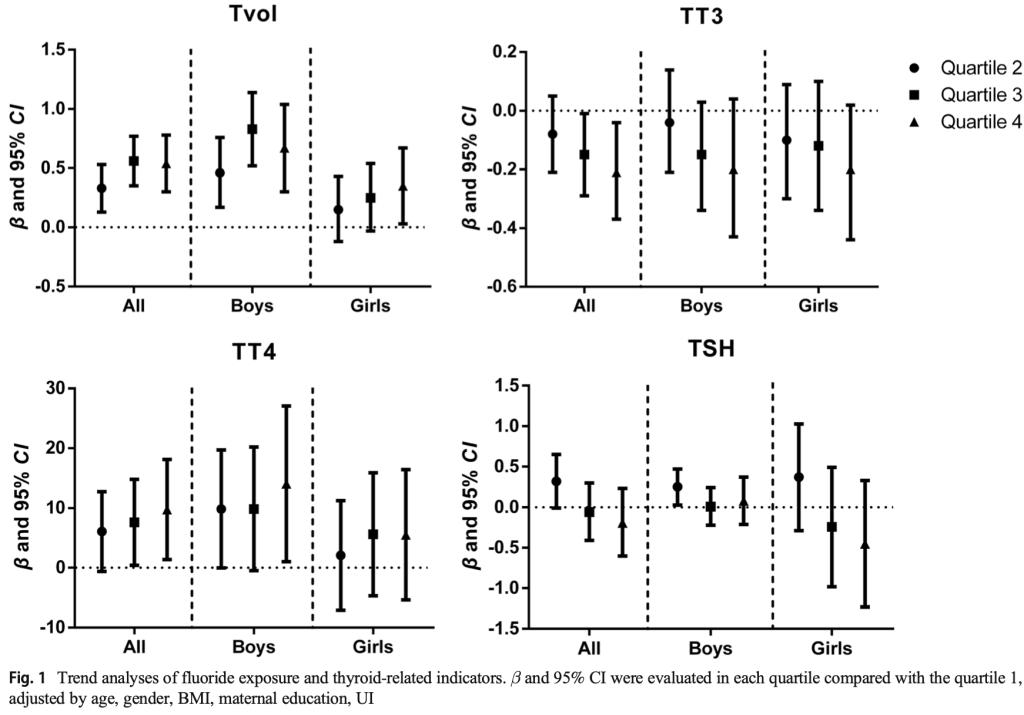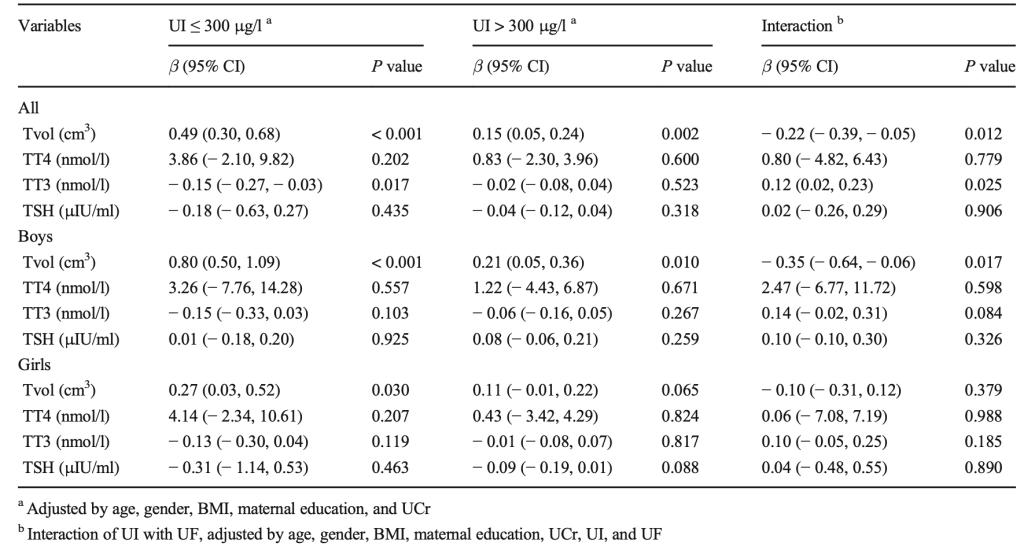
论文DOI: 10.1007/s12011-020-02519-8
Abstract:Excessive fluoride exposure has detrimental effects on the thyroid gland, which may be modified by iodine. However, the role of iodine in it remains unclear. This study aims to evaluate the role of iodine in thyroid abnormalities caused by fluoride exposure in school-age children. A total of 446 children aged 7–12 years were recruited from Tongxu County, Henan province, in 2017 (ZZUIRB 2017-018). We obtained demographic information through questionnaire surveys. The concentrations of urinary fluoride (UF) and urinary iodine (UI) were determined by the ion-selective electrode method and the catalytic spectrophotometric method, respectively. The radiation immunoassay was used to determine the serum concentrations of total triiodothyronine (TT3), total thyroxine (TT4), and thyroid-stimulating hormone (TSH). The B-mode ultrasound was performed to assess thyroid volumes (Tvols). The associations between fluoride exposure and thyroid-related indicators were tested by linear regression models. We found that Tvols increased by 0.22 (95% CI: 0.14, 0.31) cm3with each standard deviation increment of UF. Moreover, Tvols in boys were more susceptible to fluoride exposure than those in girls, and the Tvols of children with high urinary iodine are less susceptible to fluoride exposure (P for interaction < 0.05). We also observed that TT3 levels were negatively related to UF concentrations at moderate urinary iodine levels (≤300μg/l). Fluoride exposure can elevate the Tvols of school-age children, especially in boys, and high levels of iodine may alleviate this effect to some extent.
摘要:过量氟暴露可以引起甲状腺损伤,碘可能修饰这种作用。然而,碘在其中的作用尚未完全阐明。本研究旨在探索碘在氟暴露引起的儿童甲状腺损害中的作用。研究在河南省通许县招募446名7-12岁学龄儿童作为研究对象。通过问卷调查获取一般人口学信息,并收集尿样和血样。分别采用氟离子选择电极法和催化分光光度法测定尿氟和尿碘浓度。采用放射免疫法测定血清总三碘甲腺原氨酸(TT3)、总甲状腺激素(TT4)和促甲状腺激素(TSH)。采用B超声评估甲状腺容积(Tvols)。并采用多重线性回归探究氟暴露与甲状腺相关指标的关系。研究发现儿童尿氟每增加1个标准差,Tvols可增大0.22(95% CI: 0.14~0.31)cm3。与女童相比,男童的Tvols更易受氟暴露的影响;而尿碘浓度较高的儿童Tvols对氟暴露不敏感。结论:氟暴露可以引起学龄儿童Tvols改变,其中男孩的Tvols更易受氟暴露影响,而高碘可拮抗由氟暴露引起的甲状腺损害。
图文导读:
(一)氟暴露对甲状腺相关指标的影响

研究探究了氟暴露与甲状腺相关指标关联的趋势性,结果提示氟暴露与Tvols、TT3与TT4均存在线性关联。进一步进行线性回归发现氟暴露可以引起Tvols的改变,尿氟每增加1个标准差,Tvols增大0.22(95% CI: 0.14~0.31)cm3。且氟对Tvols的效应存在性别差异,男孩的Tvols更易受氟暴露的影响(P交互=0.038)。详见下表。
表1 氟与甲状腺相关指标的关联分析

(二)不同尿碘浓度下,氟暴露对甲状腺相关指标的影响

较低尿碘儿童TT3随尿氟水平升高而降低,而较高的碘水平可减缓氟暴露造成的甲状腺损害。
小结:
该研究评估了氟暴露对甲状腺相关指标的影响,并且探索了碘在其中的作用。研究提示氟暴露可以引起学龄儿童甲状腺容积(Tvols)改变,其中男孩的甲状腺容积更易受氟暴露影响,而高碘可拮抗氟暴露引起的甲状腺损害。
参考文献:
Yuhui Du, Guoyu Zhou, Biao Gong, Jun Ma, Ning An, Minghui Gao, Meng Yang, Qiang Ma, Hui Huang, Qiting Zuo, Yue Ba*. Iodine Modifies the Susceptibility of Thyroid to Fluoride Exposure in School-age Children: a Cross-sectional Study in Yellow River Basin, Henan, China. Biological trace element research, 2021.
DOI:10.1007/s12011-020-02519-8
文章链接:
https://doi.org/10.1007/s12011-020-02519-8

